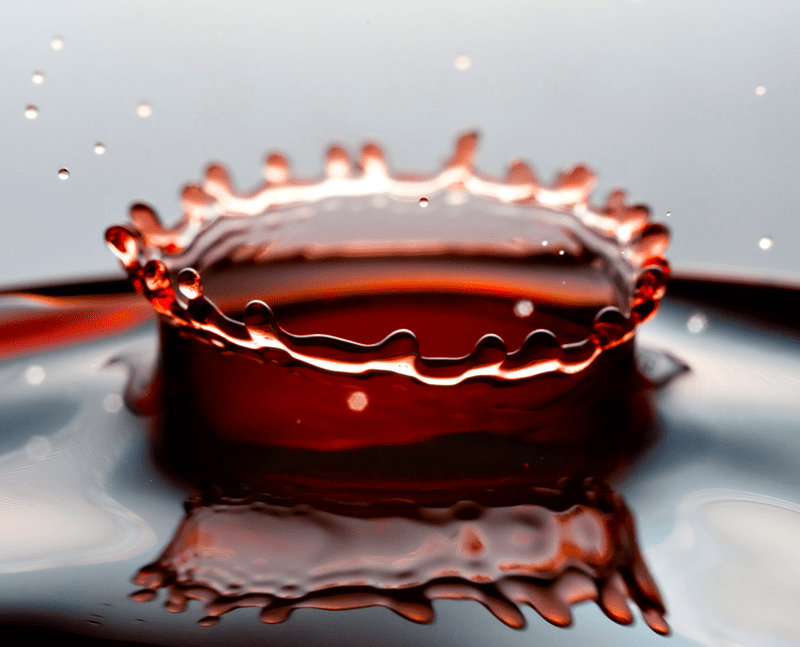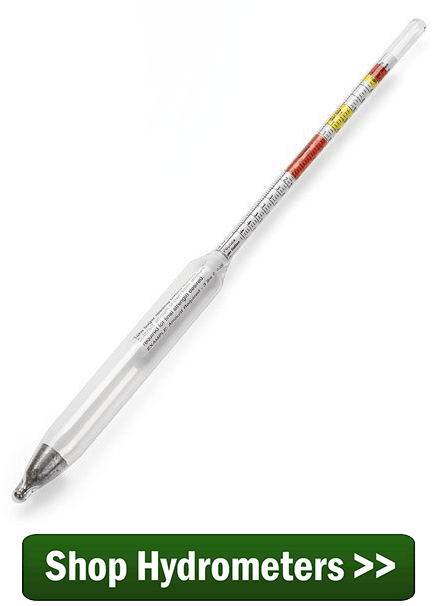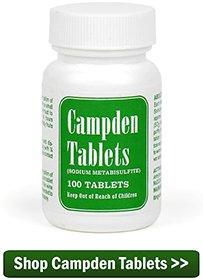 I have made this wine several times — has always turned out very well. However, this time (same recipe), the wine’s not clearing. I have changed the carboy 3 times since early November, still not clearing. (Did the flashlight test). The temperature in the room stays perfect for it — just don’t understand it… It smells wonderful! Any advice, would be greatly appreciated!
I have made this wine several times — has always turned out very well. However, this time (same recipe), the wine’s not clearing. I have changed the carboy 3 times since early November, still not clearing. (Did the flashlight test). The temperature in the room stays perfect for it — just don’t understand it… It smells wonderful! Any advice, would be greatly appreciated!
Name: Laura
State: MN
—–
Hello Laura,
Sorry you’re having such a stubborn time with a cloudy wine, but don’t give up on it just yet. Having a cloudy wine is usually not a catastrophic event, but more like to be just an annoyance with a solution.
But before we can solve the problem we have to identify the problem. The cloudiness is only a symptom. We need to know why the wine is still cloudy? Until we have the answer to that we don’t know what action to take.
- Your wine may still be fermenting.
The first thing to look at is the specific gravity of the wine. This will tell us how much sugar is still left in the wine, if any. This is easily checked with a wine hydrometer. If the specific gravity indicates that there is still sugar in the wine, then the probable reason you have a cloudy wine is because your wine is still fermenting very slowly, but enough to keep things stirred up.It is important to note that the slightest amount of fermentation can cause a lot of cloudiness in a wine, so do not rule this reason out just because you have not seen any bubbles come out of the air-lock. If the hydrometer indicates that the fermentation has not completed, then this is most likely the reason you have a cloudy wine. The only way to solve this problem is to get the fermentation to complete… to make sure the wine yeast are happy and provided with the environment needed to finish the job. One article that you might want to take a look at is, “The Top 10 Reasons For Fermentation Failure“. You can go over these reasons and see if any of them ring true to your situation.

- Your wine may have a pectin haze.
This could be particularly true if your wine recipe does not call for a pectic enzyme to break down the pectin cells in the fruit. While the fermentation activity itself will quite often break down the pectin, there are many times it will not. This is why it is usually advisable to add pectic enzyme to any fruit wine recipe — whether it calls for it or not. There is no downside to doing so.One way to test for a pectin haze is to take a 4 ounce sample of the wine in question and add ¼ teaspoon of pectic enzyme to it. Allow the mixture to sit for a few hours or until the wine has become clear. If the wine does not clear then you do not have a pectin haze. If the wine does clear, then pectin haze is why you have a cloudy wine.The only thing you can do to the wine at this point would be to add a double-dose of pectic enzyme to the entire batch of wine (use the dosage listed on the container it came in). Then give it several weeks time, if not months, to clear. Patience is crucial in the particular instance.
- Tannin falling out of the wine.
Tannin is the bitter zest found mostly in the skin of a fruit. Any wine can only hold so much tannin before it will start to release it as a precipitate. One way to test for this is to heat a pint sample of the wine in a sauce pan and see if it clears. If it does then tannin is the issue. You can find more information on our website on the subject. You might want to look over the article: “Maintaining Temperature Stability In Your Wines“.
- Your wine has a bacterial infection.
If you added sulfites such as Campden tablets or sodium metabisulfite before and after the fermentation, this is not likely to be your problem. But if you didn’t, then there is a likelihood that a bacterial infection of sorts is the reason why you have a cloudy wine. You mentioned that the wine smelled great, so I doubt that this is your problem. Wines with this type of fault will smell bad before they taste bad. A simple way to test for this is to smell the wine. If you notice a fingernail polish type smell or an odor of sauerkraut, then this is likely to be what’s going on.A bacterial infection has taken over the wine.Of all the the reasons for having a cloudy wine, this is the worst one. An uncontrolled bacterial infection means the wine is un-salvageable and that you should cut your losses and dispose of the wine. Hopefully, this is not the case.
You mentioned that the wine smelled great, so I doubt that this is your problem. Wines with this type of fault will smell bad before they taste bad. A simple way to test for this is to smell the wine. If you notice a fingernail polish type smell or an odor of sauerkraut, then this is likely to be what’s going on.A bacterial infection has taken over the wine.Of all the the reasons for having a cloudy wine, this is the worst one. An uncontrolled bacterial infection means the wine is un-salvageable and that you should cut your losses and dispose of the wine. Hopefully, this is not the case.
Another blog post that may help you with your cloudy wine is “Clearing A Cloudy Wine…“. This is about another fellow winemaker with similar problems to what your are describing.
Hope this information helped you out. Best wishes and happy wine making,
Ed Kraus
—–
Ed Kraus is a 3rd generation home brewer/winemaker and has been an owner of E. C. Kraus since 1999. He has been helping individuals make better wine and beer for over 25 years.

Bentonite works for me every time.
Had a cloudiness problem in 2014 with my Chardonnay. Used Bentonite, then Isinglas with no result. I racked the wine then let it sit until May when it was pretty clear. I filtered the Chardonnay and bottled for a really clear, rich looking pale yellow and what I considered a pretty tasty drink.
It took more patience than technology.
I have an apple wine that wont clear I have tried bentonite and super clear can I try either one again without damaging the wine/
Jerry, if you have verified with your hydrometer that the fermentation is complete and you have added fining agents twice, adding a third dose will not help. It sounds like you may have a pectin haze which is listed as number 2 in this article. Fining agents will not clear a pectin haze. Below I have posted the link to another article that will tell you how to test for a pectin haze as well as how to treat it.
Cloudy Wine
http://www.eckraus.com/blog/homemade-wine-is-cloudy
Many fruits contain Pectin but Apples are at the top of the list a pectin enzyme used during the mashing and fermentation process will work wonders.
Pectic Enzyme (ENZ110) is recommended for all fresh fruit wines. Add the Pectic Enzyme to the juice prior to the fermentation process in order to enhance the clarification process. EC Kraus carries this item
My strawberry wine has an odor and taste similarly to vinegar, however, I used Camden tablets before and after fermentation and at each racking. What could be the problem and is it salvageable?
Bernadell, there are several reasons that can cause a wine to turn to vinegar as explained in the article posted below. Slow fermentation and a fermentation that is too warm are a couple of the reasons. Unfortunately, if the wine has formed vinegar, there is nothing that you can do to reverse this. Using campden tablets can help to prevent more from forming.
My Wine tastes Like Vinegar
http://blog.eckraus.com/wine-taste-like-vinegar
Strawberry wine is a low acid wine and very prone to going bad. If any little islands form on the top of the wine remove them and add the appropriate amount of Campden and rack ASAP but siphon off the the wine without getting the islands of mold.. I found that making a Strawberry Rhubarb wine did much better as the Rhubarb is higher in acid and is quite delightful when sweetened and aged properly.
As wine becomes more and more clear, you do NOT want to add Campden tablets, because the cloudy white filler (that surrounds the tiny grains of meta) will haze up your wine and defeat the whole clarification process that you have been patiently waiting to accomplish. Therefore, Campden tablets are used only at the beginning stages, and later on, you should switch to powdered sulphite to avoid this.
Wish I had read this earlier, I had a crystal clear quince wine then decided to add 2 campden tablets ( for 10 litres of wine ) to stop future oxidation and it instantly turned cloudy. So not sure what to now . Will wait a month and see what happens otherwise down the gurgler arrgh.
You do no use Campden tablets to prevent oxidation you use Ascorbic Acid better known as Vitamin C. And Potassium Sorbate to prevent further fermentation if you have a sweet wine. I use 500 mg tablet crushed for a gallon of wine just make sure to add campden at this time if you haven’t done so in a while the SO2 levels must be above 30 ppm so if you haven’t added in a while racking is the perfect time.
We are having issues with cloudiness with a 5 gallon batch of pawpaw wine. It tastes and smells amazing, but it is super cloudy. We added a double dose of pectic enzyme and are trying to wait patiently to see if it clears. Once is does, do we need to add campden to it before bottling?
Lisa, yes, at bottling time you will want to add one campden tablet for each gallon of wine.
All this tips you give are so useful, you should put them in a book. Would sell like hot-cakes.
I am making white wine for the first time, using juice and not grapes and it has turned a milky yellow color during fermentation. The fermentation is not quite done yet but wanted to know if this was normal.
David, If it is still fermenting it is normal for it to have a milky appearance. Once the fermentation completes, you should start to see it clear up.
I am working 4 batches of 3 gallon fruit wines. All were started within a few days and progressing about the same. Added bentonite at 1 tablespoon/gallon to all 4 batches to aide in clearing. Racked today after setting about 10 days. Decided to check tartaric level and ph. Found all 4 batches tartaric level went up average of .15 and ph went up. Now I must use Calcium carbonate to bring levels back to desired level. Is this normal?
5th reason live aboard a boat the constant movement stirs up the sediment that normally stays at the bottom of the bottle. It happens over the course of a month or so depending on sea conditions. Just a fun fact